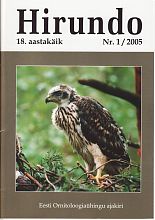Hirundo 1/2005
Tuule, E., Tuule, A. & Elts, J.
Numbers and population dynamics of the Common Sandpiper in the surroundings of Saue, 1963-2003
PDF
Väli, Ü.
Habitat use of the Red-backed Shrike in Estonia
PDF
Lõhmus, A. & Rosenvald, R.
Breeding bird fauna of the Järvselja Primeval Forest Reserve: long-term changes and an analysis of inventory methods
Summary: The Järvselja Primeval Forest Reserve (19 ha) in eastern Estonia (58°17’N, 27°19’E) was established in 1924. It contains three main forest types: mixed or broad-leaved nemoral forest (6.2 ha), Alnus glutinosa swamp forest (2.7 ha) and drained peatland forest of Pinus sylvestris (10.1 ha; Fig. 1). The area has been probably never cleared, but it is surrounded by drainage ditches. Previously, its breeding birds have been censused in 1973 and 1982 (Karoles 1975, Rootsmäe & Rootsmäe 1993).
In 2005, we mapped breeding birds in the reserve between 10 May and 17 June during seven mornings and three other visits. The aims were (1) to compare the situation with the previous censuses; (2) to check the reliability of a two-day inventory, which included a standard morning count and a later visit during the day on 10 and 31 May. Results of the inventory (maximum counts of each species) were compared with those of the standard mapping, based on two-record clusters and a careful analysis of simultaneous observations.
172 pairs of 35 species were detected (9.1 pairs ha-1). The total number of species (34-36) and of pairs (9.1-10.1 pairs ha-1) have been very stable in the three censuses (1973, 1982, 2005), though large differences appear for individual species (Table 1). These differences may be partly due to methodological aspects and annual fluctuations, but some trends may be also related to the forest dynamics in the reserve: (1) abundance of very old or dead spruces – increases of Picoides tridactylus, Certhia familiaris, Parus ater; (2) disappearance of old hollow aspens – decreases of Columba oenas, Ficedula hypoleuca, Sitta europaea; (3) overgrowth of the drained pine forest with spruce – loss of Anthus trivialis and Muscicapa striata.
In larger (>6 ha) plots, the two-day inventory resulted in c. 40% underestimation of numbers and missing of rare species; Shannon’s (but not Simpson’s) index of species diversity was almost accurate (Table 2). In the narrow and small swamp forest, many birds from the surroundings were also recorded, so this plot seemed more diverse than it actually was. We conclude that short-term inventories can be used for comparing the density and diversity in >5-ha plots; the estimation of absolute densities requires assessments of the underestimation bias.
Elts, J.
On the nest material of the Willow Warbler: a quantitative analysis
PDF
Elts, J. & Kuus, A.
The new Estonian atlas of breeding birds: results of the first study year
Summary: In 2004, compilation of the new breeding bird atlas started in Estonia. The country is divided into 2094 5×5 km-squares. Altogether 391 persons joined to project in the first study year, and up to now we have received data from 584 squares. In maximum, 122 breeding species has been observed in a square.
Mänd, R.
Benchmarks of the Estonian academic ornithology in the new independence period
Summary: During the new independence period, altogether six PhD theses have been completed by Estonian ornithologists (Peeter Hõrak, Indrek Ots, Vallo Tilgar, Asko Lõhmus, Ülo Väli, Lauri Saks), which constitutes about 6% of all doctoral dissertations in bio-geosciences during that period in Estonia. These works mostly deal with the acute problems of ecophysiology, life history evolution, sexual selection and conservation biology of birds.
‘Notes (in Estonian)*
Paal, U. Rare wintering birds in Estonia 2004/2005
Kalamees, A. & Elts, J. A Goshawk flying 70 km/h
Aun, S. & Aun, E. Water struggle between a Goshawk and a Goldeneye
Vohta, T. A Marsh Harrier attacked a Grey Heron
Sellis, U. A Marsh Harrier caught a fish
Vohta, T. A Raven helped a dog to catch a hare
Väli, Ü. An Oystercatcher bred on the roadside
Väli, Ü. On the feeding of Grey-headed Woodpecker nestlings
EOS chronicle and news (in Estonian)

